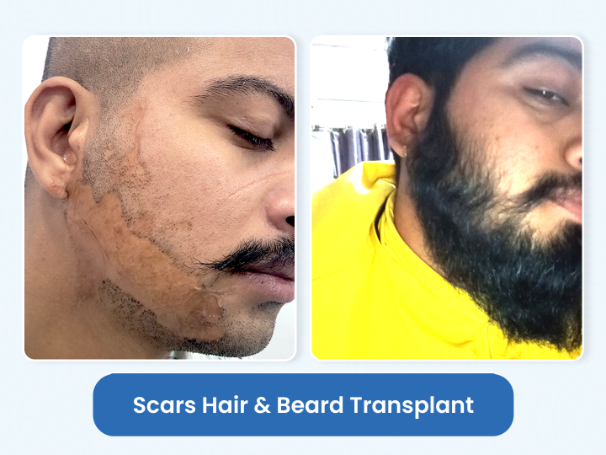Scar Hair Transplant in Nepal – Everything You Should Know

Can Hair Grow on Scar Tissue?
Scar tissue lacks hair follicles, therefore hair cannot develop there normally. Because scar tissue is a thick, fibrous tissue with poor blood circulation and limited flexibility, hair transplants on scar tissue are more challenging than on healthy skin.
However, it may be possible to use hair restoration techniques to implant healthy hair follicles into the scar, allowing them to take root, establish a blood supply, and eventually develop.
Who Can Benefit from Scar Hair Transplant?
Hair transplants on scars are for individuals with:
- Scars from accidents or trauma
- Burn injuries
- Surgical scars (e.g., after brain surgery)
- Post-tumor treatments
- Scarring alopecia
- Eyebrow scars (from cuts or injuries)
- Beard/lip scars
- Visible body scars that prevent normal hair growth
Why Is It More Challenging Than Normal Hair Transplant?
Hair transplant on scars requires special consideration:
- Limited Blood Flow:
Scarred skin has poor blood circulation that makes newly transplanted hair follicles harder for to grow. - Stiff Tissue:
Scar tissue is less elastic and thicker, making it more difficult to insert and position grafts correctly. - Healing & Aftercare:
Healing takes longer, and there is a little increased risk of problems such as infection or graft growth failure. Close follow-up is essential.
Techniques Used for Hair Transplant on Scars
At Arogin Health Care, different hair transplant methods are used depending on the scar condition and area. Here’s how each works:
B.E.S.T.(Bio-Enhanced Simultaneous Transplant)
B.E.S.T. is patented and most advanced hair transplant technique in Nepal:
- Simultaneous extraction and implantation reduce graft handling time to the minimum
- Use ATP solution to improve hair graft survival rates.
- No stitches, no visible scar, less downtime
- Only available at Arogin Health Care in Nepal
DHT (Direct Hair Transplant)
- Grafts are implanted within 2–20 minutes of harvesting.
- No long storage means higher survival rate.
- No stitches. No linear scars.
FUE (Follicular Unit Extraction)
Best for: Small to medium scar coverage
- Extracted of hair follicle one by one from back of the scalp.
- Implanted into the scar tissue manually.
- Stitch less and heals in a few days.
- Downside: Longer storage of grafts outside the body can reduce survival rate.
Why Choose Arogin Health Care for Scar Hair Transplant in Nepal?
Established Expertise
Since 2016, Arogin has performed thousands of successful procedures using international techniques.
Highly Trained Specialists
Our team includes surgeons with extensive experience in complex hair transplant cases, including post-scar and burn corrections.
Exclusive B.E.S.T. Method
We are the only center in Nepal licensed to offer the Bio-Enhanced Simultaneous Transplant, which ensures better outcomes, especially on scarred areas.
Customized Planning
Each scar case is unique. We assess tissue health, blood flow, and design your treatment for maximum natural growth.
Conclusion
Scar hair transplant in Nepal is now achievable because to technical advancements and facilities like as Arogin, which bring global competence at your door. Whether you're healing from an accident, burn, or surgery, you don't have to live with obvious scars forever.
Set up a consultation with Arogin Health Care to start the process of regrowing your hair and gaining confidence.
